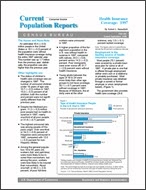Health Insurance Coverage: 1997
Health Insurance Coverage: 1997
Report Number: P60-202
The Haves and Have-Nots
An estimated 43.4 (± 0.5) million people in the United States or 16.1 (± 0.2) percent of the population were without health insurance coverage during the entire 1997 calendar year. This number was up 1.7 million from the previous year; statistically, the proportion was also higher than the previous year.
Other highlights are:
- The status of children’s health care coverage was unchanged in 1997. The number of uninsured children under 18 years of age was 10.7 (± 0.2) million in 1997, 15.0 (± 0.3) percent of all children; both the number and percent were not significantly different from the previous year.
- Despite the Medicaid program, 11.2 (± 0.3) million poor people had no health insurance in 1997, nearly one-third of all poor people, or 31.6 (± 0.7) percent.
- The highest uninsured rate was among people of Hispanic origin: Over one-third or 34.2 (± 0.6) percent of Hispanics were uninsured in 1997, compared with 12.0 (± 0.2) percent for non-Hispanic Whites.
- Among the general population 18 to 64 years old, workers (full- and part-time) were more likely to be insured than nonworkers, but among the poor, workers were less likely to be insured than nonworkers. About one-half, or 49.2 (± 2.0) percent, of poor full-time workers were uninsured in 1997.
- A higher proportion of the foreign-born population in the U.S. was without health insurance in 1997, compared with natives, 34.3 (± 0.8) percent versus 14.2 (± 0.2) percent. Poor immigrants were even worse off; 51.7 (± 2.0) percent were without health insurance.
- Young adults between the ages of 18 to 24 were more likely than other age groups to not have coverage; 30.1 (± 0.7) percent were without coverage in 1997. Because of Medicare, the elderly were at the other extreme; only 1.0 (± 0.1) percent lacked coverage.
Note: The figures above in parentheses denote the 90-percent confidence intervals.
Tables
Others in Series
Publication
Money Income in the United States: 1997
This report examines annual changes in income and earnings and compares these changes with historical trends.
Publication
Poverty in the United States: 1997
This report presents poverty data by selected characteristics and geography to illustrate how poverty rates vary.
Publication
Measuring 50 Years of Economic Change Using the March CPS
This chartbook provides a graphic overview of changes in income over the past 50 years.
Page Last Revised - October 8, 2021





